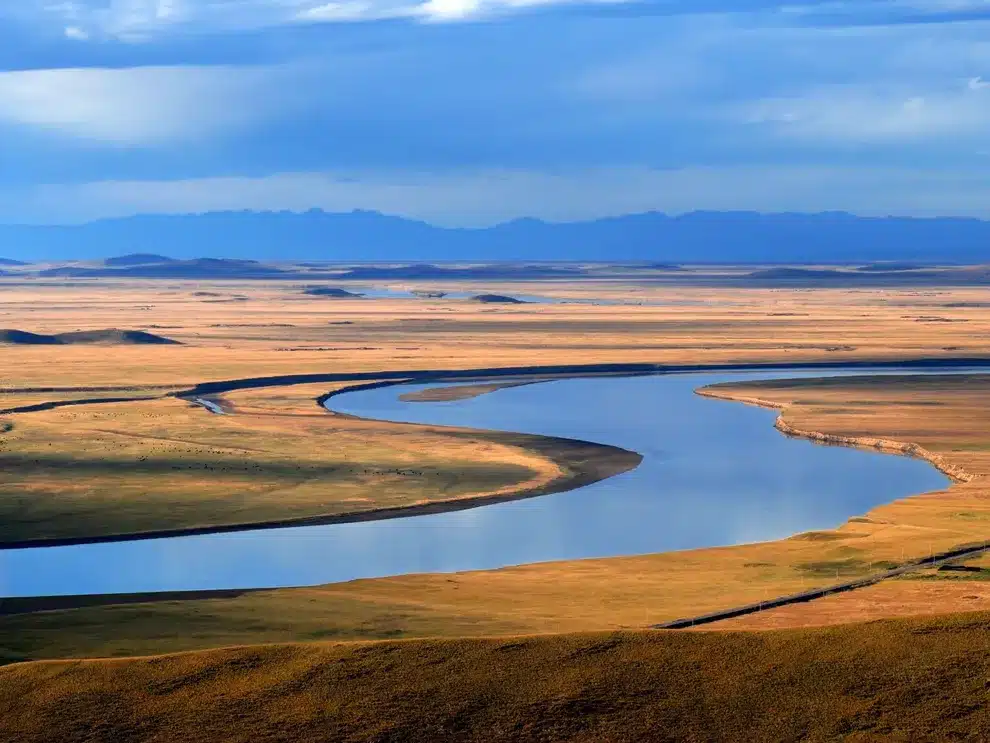About Floodplain
- A floodplain is a generally flat area of land next to a river or stream.
- It is composed of unconsolidated sedimentary deposits (alluvium) and is subject to periodic inundation by the stream.
- It stretches from the banks of the river to the outer edges of the valley.
- A floodplain consists of two parts.
- The first is the main channel of the river itself, called the floodway. Floodways can sometimes be seasonal, meaning the channel is dry for part of the year.
- Beyond the floodway is the flood fringe. It is the land between the banks of the floodway and the valley wall, or anywhere the valley land starts to rise.
- How do floodplains form? Floodplains develop in two common ways: erosion and deposition (also known as aggradation).
- When rivers start to meander, curving from side to side, the water erodes the banks of the river and creates a wide, flat area around the sides.
- When the river floods, either because of heavy rainfall or ice melting upstream, it floods its banks.
- The water that moves out of the floodway and into the fringes loses the force that was carrying much of the sediment acquired from erosion upstream and deposits it on the surrounding land.
- The portions of the river that have been consistently flooded will naturally start to build a bank up again.
- As sediment is deposited over time, most of it is deposited where the land elevates out of the river bed and creates a bank where one had previously eroded.
- These deposits flanking the river are called fluvial terraces and can tell geologists a lot about where floodplains used to be before the banks built up.
- Floodplains are absent where downcutting of rivers is dominant.
- Importance:
- The deposition of sediment that happens in floodplains can be the source of major fertility.
- This sediment is usually built up of alluvium, or silt, which is considered some of the richest soil, containing nutrients like potash, phosphoric acid, and lime.
Q1) What are sedimentary deposits?
Sedimentary deposits are mineral deposits that are formed through the accumulation of sediments on or near the Earth’s surface. These deposits can contain a variety of minerals, including metal ores, coal, and industrial minerals such as limestone, salt, and gypsum.
Source: Committee plans to define river floodplain by April 18
Last updated on December, 2025
→ Check out the latest UPSC Syllabus 2026 here.
→ Join Vajiram & Ravi’s Interview Guidance Programme for expert help to crack your final UPSC stage.
→ UPSC Mains Result 2025 is now out.
→ UPSC Notification 2026 is scheduled to be released on January 14, 2026.
→ UPSC Calendar 2026 is released on 15th May, 2025.
→ The UPSC Vacancy 2025 were released 1129, out of which 979 were for UPSC CSE and remaining 150 are for UPSC IFoS.
→ UPSC Prelims 2026 will be conducted on 24th May, 2026 & UPSC Mains 2026 will be conducted on 21st August 2026.
→ The UPSC Selection Process is of 3 stages-Prelims, Mains and Interview.
→ UPSC Result 2024 is released with latest UPSC Marksheet 2024. Check Now!
→ UPSC Prelims Result 2025 is out now for the CSE held on 25 May 2025.
→ UPSC Toppers List 2024 is released now. Shakti Dubey is UPSC AIR 1 2024 Topper.
→ UPSC Prelims Question Paper 2025 and Unofficial Prelims Answer Key 2025 are available now.
→ UPSC Mains Question Paper 2025 is out for Essay, GS 1, 2, 3 & GS 4.
→ UPSC Mains Indian Language Question Paper 2025 is now out.
→ UPSC Mains Optional Question Paper 2025 is now out.
→ Also check Best IAS Coaching in Delhi

















